by Joe Hoft

There are numerous questions related to what happened in the State Farm Arena in Fulton County Georgia during the 2020 Election. The Arena was used as the Fulton County ballot processing center and is where reportedly all 148,318 absentee ballots were scanned.
Ballots processed in the Arena were expected to be authenticated first. Voters were to be identified on voter logs and then signature verification was to take place. The ballots were then to be separated from their envelopes and arranged in batches of approximately 100. Each batch was then scanned using one of the five Cannon DR-G2140 high-speed machines [as can be observed in video from the Arena on Election night.] The image of each ballot was simultaneously created and saved.
One individual examining the data (RonC) identified something he could not explain. The image files have timestamps that are recorded as the ballots are being scanned. Those timestamps reveal that the image files were created faster than the physical capacity of the scanners used in the process. In many cases, several times faster.
The manual for the Cannon DR-G2140 lists the specifications on page 23: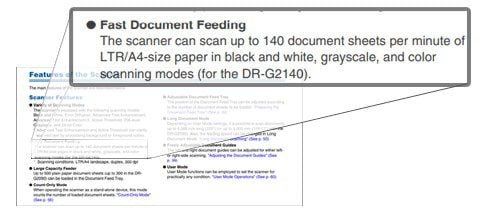
The manual for the Cannon DR-G2140 lists the specifications on page 23:

Using the State Farm Arena surveillance video, a group of professionals analyzing the data measured the actual realized scan times which averaged approximately 80 seconds per batch (under perfect conditions with no paper jams or complications). Which equates to approximately 1.25 ballots per second.
However, the image timestamps show something different. Below is a spreadsheet of sample data that has the timestamp of each ballot image as it was created. This information came from Fulton County and was produced in the court case above.
Below is image data of actual ballots scanned by unit 5162 on 11-05-2020.
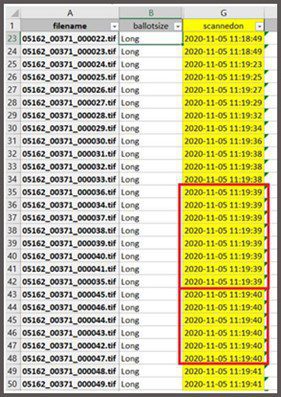
The timestamps in the red boxes above show 8 ballots scanned in the same second, followed by 6 ballots in the very next second. Fourteen ballots in 2 seconds!?!?
This shows that the ballot images were created at a speed that is physically IMPOSSIBLE.
These results are not possible.
The same scenario is replete throughout the image files and affects thousands of ballots. These results certainly aren’t expected or “normal”.
There’s more. If we expand the same dataset to include the modified file timestamps, we reveal additional problems:
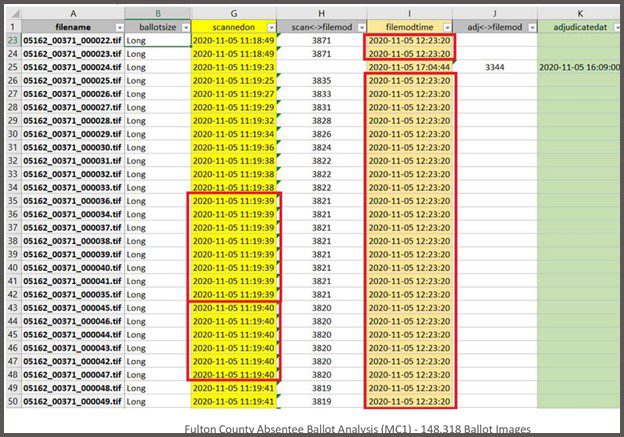
The only instance in which a ballot image file should be modified is if it has gone through the adjudication process. Adjudication is when the machine cannot determine the voter’s selections for various reasons and the ballot is supposed to be sent to a bi-partisan team who looks at the markings and attempts to interpret the voter’s intent. The team votes and if they agree, the original image is supplemented to reflect the decision.
The modified timestamps shown above reveal that all of the files were modified.Again, the ballot images should not be modified unless processed for adjudication. Adjudication should only be used only in rare circumstances. [We’re not sure of the official percent but we believe adjudication should only occur in less than 2% of all ballots processed.] Perhaps there is a reasonable explanation for all of these ballots being adjudicated. Maybe this was caused by a technicality only affecting these ballots? But the images appear to have been all modified at the same time, and within only one hour of scanning.
If we zoom out to the 30,000-foot level and look at all batches from the same scanner as shown below, we see a much larger problem. First, all of the batches have been modified as shown on the far right. The scan times for each batch are in yellow and the numbers shown in red are the amount of time (hours) between when the batch was scanned and when the batch was modified.
For example, batch 001 was finished being scanned at 1:51 pm on 10/22. That same batch was modified 192 hours later at 1:38 pm on 10/30.
The batch was scanned and then modified 8 DAYS LATER.
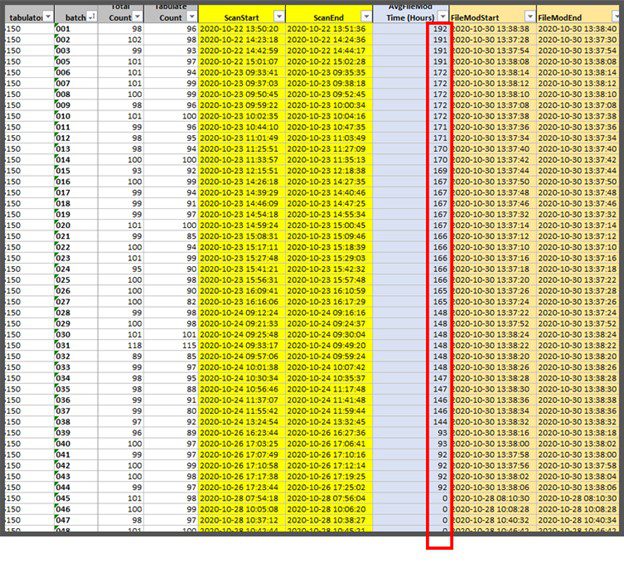
On scanner 5150, a total of 44 batches were modified between 3 to 8 days after being scanned. Not only is such a large window of time used to process ballots inexplicable, but it is also unacceptable. Unfortunately, these findings show extreme variations in the process, are widespread, and cannot be dismissed or ignored.
Important is the last 4 batches shown on the page had 0 hours between the scan time and modification time. In fact, the last 4 batches scanned were modified before the previous 44 batches. This removes the possibility of some type of consistent procedure or forced process causing the modification of all batches on the same date.Remember, the findings above only show the anomalies associated with one of the five machines used to scan absentee ballots, a process that continued until November 5th. (More to come soon on the significance of the time between scanning and file modification time.)
Attempting to seek understanding and answers for his findings, RonC went to the logical government entity charged with such matters- the Fulton County Board of Registration and Elections (BRE).
RonC summarized his findings in an email that detailed the scan speed and image file modification issues. The BRE then sought answers from the County Elections Director, Rick Barron. The email below shows Mr. Barron’s response to the board:
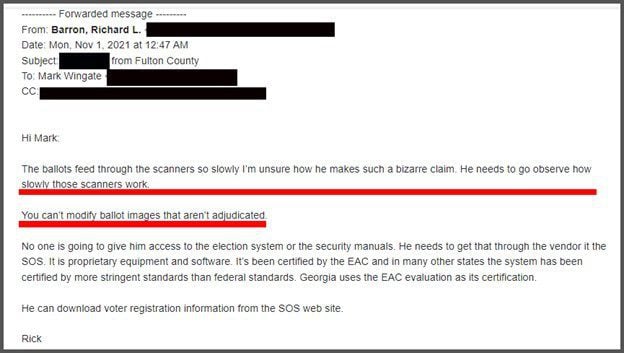
There are 4 basic takeaways from Mr. Barron’s email.
First, it’s obvious that Mr. Barron feels the same about the impossible scanning speed and went so far as to describe RonC’s finding as “bizarre”. The problem is this was not simply a “claim” as characterized by Mr. Barron, rather a factual observation of Fulton County’s data.
Secondly, Mr. Barron directly states: “You can’t modify ballot images that aren’t adjudicated.” Again, he affirms our understanding and expectations.
Third, he states that the equipment is proprietary, and the security manuals are not available. In his defense, Mr. Barron was probably referencing the election system as a whole or in a general connotation; however, the scanners used were Cannon consumer-off-the-shelf machines that can be purchased through numerous retailers.
Finally, we did follow Mr. Barron’s advice to observe the scanners in operation by watching the State Farm Arena surveillance video. He was correct, the scanners are slow. In fact, they are so slow that the ballot images produced by the scanner are created faster than the machine can scan the ballots, and that truly is “bizarre”.
There is more to this story.Kevin Moncla
“RonC” contributed to this report
